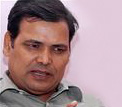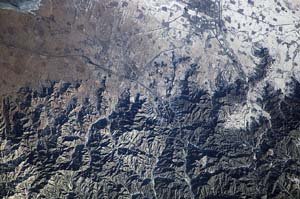A chronology of key events:1768 - Gurkha ruler Prithvi Narayan Shah conquers Kathmandu and lays foundations for unified kingdom.

Mount Everest, known in Nepal as "Sagarmatha"
1792 - Nepalese expansion halted by defeat at hands of Chinese in Tibet.
1814-16 - Anglo-Nepalese War; culminates in treaty which establishes Nepal's current boundaries.
1846 - Nepal falls under sway of hereditary chief ministers known as Ranas, who dominate the monarchy and cut off country from outside world.
1923 - Treaty with Britain affirms Nepal's sovereignty.
Absolute monarchy1950 - Anti-Rana forces based in India form alliance with monarch.
1951 - End of Rana rule. Sovereignty of crown restored and anti-Rana rebels in Nepalese Congress Party form government.
Nepal's Sherpa Tenzing Norgay and Sir Edmund Hillary were the first to the top of the world
1953 29 May - New Zealander Edmund Hillary and Nepal's Sherpa Tenzing Norgay become the first climbers to reach the summit of Mount Everest.
1955 - Nepal joins the United Nations.
1955 - King Tribhuwan dies, King Mahendra ascends throne.
1959 - Multi-party constitution adopted.
1960 - King Mahendra seizes control and suspends parliament, constitution and party politics after Nepali Congress Party (NCP) wins elections with B. P. Koirala as premier.
1962 - New constitution provides for non-party system of councils known as "panchay

at" under which king exercises sole power. First elections to Rastrya Panchayat held in 1963.
1972 - King Mahendra dies, succeeded by Birendra.
Multi-party politics1980 - Constitutional referendum follows agitation for reform. Small majority favours keeping existing panchayat system. King agrees to allow direct elections to national assembly - but on a non-party basis.
1985 - NCP begins civil disobedience campaign for restoration of multi-party system.
1986 - New elections boycotted by NCP.
King Mahendra's 1962 constitution cemented royal rule
1989 - Trade and transit dispute with India leads to borde

r blockade by Delhi resulting in worsening economic situation.
1990 - Pro-democracy agitation co-ordinated by NCP and leftist groups. Street protests suppressed by security forces resulting in deaths and mass arrests. King Birendra eventually bows to pressure and agrees to new democratic constitution.
1991 - Nepali Congress Party wins first democratic elections. Girija Prasad Koirala becomes prime minister.
Political instability1994 - Koirala's government defeated in no-confidence motion. New elections lead to formation of Communist government.
1995 - Communist government dissolved. Radical leftist group, the Nepal Communist Party (Maoist) begins insurrection in rural areas aimed at abolishing monarch and establishing people's republic.
1997 - Continuing political instability as Prime Minister Sher Bahadur Deuba is defeated and replaced by Lokendra Bahadur Chand. Chand is then forced to resign because of party splits and is replaced by Surya Bahadur Thapa.
1998 - Thapa stands down because of party splits. GP Koirala returns as prime minister heading a coalition government.
1999 - Fresh elections give majority to Nepali Congress Party. Krishna Prasad Bhattarai becomes prime minister.
2000 - Prime Minister Bhattarai steps down after revolt in Nepali Congress Party. GP Koirala returns as prime minister, heading the ninth government in 10 years.
2001 April - General strike called by Maoist rebels brings life in much of the country to a virtual standstill; police arrest anti-government demonstrators, including some opposition leaders, in Kathmandu.
Palace killings
2001 1 June - King Birendra, Queen Aishwarya and other close relatives killed in shooting spree by drunken Crown Prince Dipendra, who then shoots himself.
2001 4 June - Prince Gyanendra crowned King of Nepal after the late King Birendra's son, Dipendra - who had been declared king on 2 June - died of injuries sustained during the palace shooting.
2001 July - Maoist rebels step up campaign of violence. Sher Bahadur Deuba becomes prime minister, heading the 11th government in 11 years, after Girija Prasad Koirala quits over the violence.
2001 July - Deuba announces peace with rebels, truce begins.
2001 November - Maoists say peace talks have failed, truce is no longer justified. Launch coordinated attacks on army and police posts.
Emergency
2001 November - State of emergency declared after more than 100 people are killed in four days of violence. King Gyanendra orders army to crush the Maoist rebels.
2002 February - Maoists kill 127 in weekend raids on several government targets.
2002 April - Maoist rebels order five-day national strike, days after hundreds are killed in two of bloodiest attacks of six-year rebellion.
2002 May - Intense clashes between military and rebels in the west. Rebels declare one-month ceasefire, rejected by government.
Deuba visits Britain and other states, seeking help in the war against Maoist rebels. US President George W Bush pledges $20 million.
2002 May - Parliament dissolved, fresh elections called amid political confrontation over extending the state of emergency. Deuba expelled by his Nepali Congress party, heads interim government, renews emergency.
2002 October - Deuba asks king to put off elections by a year because of Maoist violence. King Gyanendra dismisses Deuba and indefinitely puts off elections set for November. Lokendra Bahadur Chand appointed to head government.
2003 January - Rebels, government declare ceasefire.
2003 May/June - Lokendra Bahadur Chand resigns as prime minister. King appoints his own nominee Surya Bahadur Thapa as new premier.
End of truce
2003 August - Rebels pull out of peace talks with government and end seven-month truce. Rebels call three-day general strike in September.
Maoist rebels demand an end to constitutional monarchy
late 2003 onwards - Political stalemate; clashes between students/activists and police; resurgence of violence.
2004 April - Nepal joins the World Trade Organisation (WTO).
2004 May - Royalist Prime Minister Surya Bahadur Thapa resigns following weeks of street protests by opposition groups.
2004 June - King Gyanendra reappoints Sher Bahadur Deuba as prime minister.
2004 August - Maoist rebels stage week-long blockade of Kathmandu, stopping supplies from reaching the city.
Twelve Nepalese hostages in Iraq are murdered by their captors, sparking violent protests in Kathmandu.
Direct power
2005 1 February - King Gyanendra dismisses Prime Minister Deuba and his government, declares a state of emergency and assumes direct power, citing the need to defeat Maoist rebels.
2005 30 April - King lifts the state of emergency.
2005 July - Royal anti-graft commission sentences former Prime Minister Deuba to two years in jail for corruption. He is freed in February 2006, after the commission is outlawed.
2005 September - Rebels announce a three-month, unilateral ceasefire, the first truce since peace talks broke down in 2003. The truce is later extended to four months.
2005 November - Maoist rebels and main opposition parties agree on a programme intended to restore democracy.
2006 January - Maoist rebels announce end to four-month ceasefire.
 party alliance should continue for the next 10 years at least.
party alliance should continue for the next 10 years at least. party alliance should continue for the next 10 years at least.
party alliance should continue for the next 10 years at least.





























